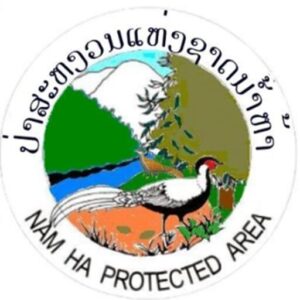Nam Ha National Protected Area, Luang Namtha Province
In 1993, the government of Lao PDR established a series of protected areas called National Protected Areas (NPA). They comprise approximately 12.5 percent of the nation’s land, a remarkably high percentage that represents a positive step towards the preservation of the nation’s unique and valuable natural heritage.
The mountainous Nam Ha NPA stretches from the Chinese border to Bokeo Province, and is populated with ethnic communities. Mixed deciduous forest covers most of the NPA, especially in the 1,000 metre-high eastern mountains. The western range’s dry evergreen forest and grasslands run from Vieng Phoukha to the Chinese/Lao border, and two of its peaks top 2,000 meters. Dozens of rivers and streams cross the Nam Ha’s rugged landscape.
The 222,400 square hectare, the park covers about 24% of Luang Namtha Province. Nam Ha NPA recieved tourism awards: In 2001 the United Nation Development Award for “ Nam Ha Eco-tourism Project ”, in 2002 the British Airways “Tourism for Tomorrow”, in 2003 it was designated as an ASEAN Heritage Site, in 2007 the Equator Prize for “ Nam Ha Eco-guide Service ”, and in 2019 the ASEAN Tourism Standard for ASEAN Community-based Tourism Award in 2019-2021. More..>>
Nam Ha NPA is home to a variety of animals, plants and birds, a number of which are globally threatened by hunting and increasing loss of habitat. Some of the more spectacular mammals that are found in the protected area are tigers and the beautiful clouded leopard, macaques, pangolins, wild Asian elephants, Asiatic black bears, Malayan sun bears, gaur, and wild boar. Having been hunted and trapped for centuries, larger mammals are very shy of human beings, thus sightings are rare. However, scat and footprints can be found along the trail and near riverbanks. For those interested in bird watching, a surveys report nearly 300 bird species.
The Nam Ha NPA is also home to people. Twenty-five villages lie within its boundaries. The lives of people in these villages have been integrated with the forests for centuries. People use the forest for their daily subsistence needs, but also protect it, recognizing the need to sustain it for future use. As such the villagers are both exploiters and managers of the forest. In the process of creating the regulations for the NPA, the villagers will play an important long-term supervisory role.














 Users Today : 11
Users Today : 11 Users Yesterday : 106
Users Yesterday : 106 This Month : 551
This Month : 551 This Year : 16559
This Year : 16559 Total Users : 92521
Total Users : 92521 Views Today : 13
Views Today : 13 Who's Online : 1
Who's Online : 1